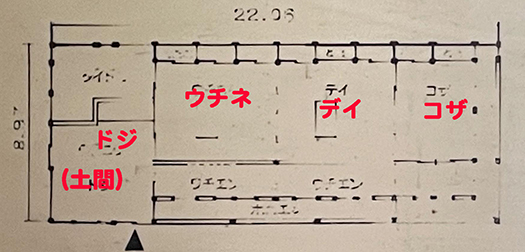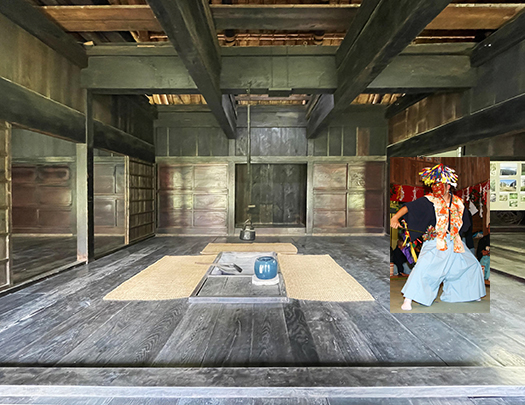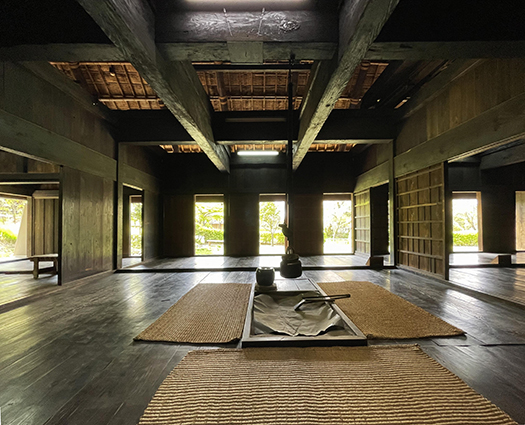


住宅の情報の世界という現役時代からやや離陸してきて、自分なりに「ライフワーク」みたいにして「人間と住空間」というテーマ領域に自由な想像力を巡らせつつある。
住宅雑誌発行の立場から実際の住宅を取材し続けてきて、結局家づくりの究極の意味とは「施主さん」の人生観や生き方の模索の結果なのだと思い至る。
作り手は豊かな想像力を持って、施主さんの内面の叫び声を「聞き取って」その本然を活かせる空間を形象化するということなのだろう。現代ではその「人生観や生き方」というものに強い「定型」概念がなくなってきつつある。そこに確かな「洞察力」を見出しにくくなっている。自由な社会というのは、規範の根拠、強い思いが成立しにくくなる、ということなのだろうか。
試行錯誤のなかから、ある一定の「規範」が育っていくそのプロセスに現代はいるのかも。
一方で、この椎葉地域では、平家落人という地域社会の出発点についての価値感共有がある。
現代生活ではテレビや映画、WEBやSNSといった情報との接触が「娯楽」のベースになっているけれど、ここでは閉ざされた地域社会という環境の中で、独自の共有文化・純粋培養された「椎葉神楽」という独自文化が営々と続けられてきているのだという。約400年の伝統を持つ文化で、村内26箇所に伝承されている。毎年11月から12月に掛けて神社に限らず民家を舞台にして33番が夜を徹して奉納される。
説明書きでは「採り物舞〜とりものまい〜剣や扇など採り物を持って舞う」と神楽面を付ける仮面舞を交えて舞われる。簡素化されない古い形式を遺した、繰り返しの多い<陶酔神楽>であることが特徴。
この「陶酔神楽」という言葉に刺激されるけれど、いろいろ調べてみても内容が明瞭には伝わってこない。しかしわたしのわずかな神楽鑑賞体験から考えると、なんとなく「劇的空間」性が伝わってくる。イメージ的には盛り上がっていく劇的高揚感に舞台と観客が一体化して、同じシーンをなんども繰り返して、劇空間全体が陶酔に舞い上がっていく光景が想像される。

そういう劇空間がこの椎葉神楽では地域の民家で持ち回って33番も続けられるというのだ。
この地域の住宅ではこの神楽が上演されるとき、住宅中央の「デイ」で演じられ、「コザ」は楽師・世話人たちの控えの間になる。村人達はその舞台から流れる縁側、ウチエン・ホカエンに坐ってこの集団陶酔を楽しんでいたのだという。住宅の構造・様式それ自体が、この神楽文化にジャストフィットされているワケだ。<写真中、デイの写真に仮面神楽の舞い手を画像で嵌め込んでみた。>
現代住宅は、現代生活というまだ定型化以前の暮らしようと呼吸を揃えている過程だろうけれど、さてこの椎葉の家々の持っていた暮らしの中での「陶酔感」にまで暮らし文化として昇華できるだろうか。
English version⬇
Shiiba Kagura, a pure culture of mountain village culture, Heike Village, Hyuga, Japan-4
The explanation of “Euphoric Kagura” with many repetitions stimulates the imagination. Each family shares the euphoria of the dramatic space of the Heike Rakunin Mura. A high level of folk culture. The Heike Village
I have somewhat taken a break from the world of housing information in my working days, and I am beginning to let my imagination run free in the thematic area of “human beings and living space” as if it were my “life work” in my own way.
After covering actual houses from the perspective of a housing magazine publisher, I have come to realize that the ultimate meaning of house building is the result of a search for the “client’s” view of life and way of living.
The builder must have a rich imagination to “listen” to the client’s inner cries and give form to a space that can make the most of the client’s true nature. Today, there is no longer a strong “fixed” concept of “views of life and a way of life. It is becoming harder to find solid “insight” in them. Does a free society mean that it is harder to establish a basis for norms and strong feelings?
Perhaps we are now in the process of developing certain “norms” through trial and error.
On the other hand, in the Shiiba area, there is a shared sense of value about the starting point of the local community, the Heike Rakunin.
In modern life, entertainment is based on contact with information through TV, movies, the Internet, and SNS, but in the closed environment of the local community, a unique culture called “Shiiba Kagura,” which is a unique, shared, and purely cultivated culture, has been carried on for many years. This culture has a tradition of about 400 years, and has been handed down in 26 places in the village. Every year from November to December, 33 performances are dedicated throughout the night, not only at shrines, but also at private homes.
According to the description, “Torimono-mai (dance with a sword, fan, or other object to be picked)” is performed with a masked dance in which people wear kagura masks. It is characterized by its repetitiveness and its unabridged old form.
The word “euphoric kagura” is very stimulating to me, but I could not get a clear picture of what it is about even though I looked it up in various ways. However, based on my limited experience of kagura viewing, I can somehow sense the “dramatic space” nature of this form of kagura. In my imagination, the stage and the audience are united in a dramatic upsurge of excitement, and the same scene is repeated over and over, and the entire theater space is filled with a sense of euphoria.
In this Shiiba Kagura, such a theatrical space is used for 33 performances, which are rotated among the houses in the community.
When this kagura is performed in the houses in this area, it is performed in the “dei” in the center of the house, and the “koza” is the antechamber for the musicians and caretakers. The villagers would sit on the uchiwen hokaen, the porch that flows from the stage, and enjoy this collective euphoria. The structure and style of the house itself is perfectly suited to this Kagura culture. <The picture of Day in the photo below shows a masked kagura dancer. >The modern house is still a part of modern life, but it is not yet a part of the modern house.
Modern houses are still in the process of adjusting themselves to the pre-conventional lifestyle of modern life, but I wonder if they will be able to sublimate the “euphoria” of the houses of Shiiba into a living culture.
Posted on 6月 4th, 2024 by 三木 奎吾
Filed under: 日本社会・文化研究







コメントを投稿
「※誹謗中傷や、悪意のある書き込み、営利目的などのコメントを防ぐために、投稿された全てのコメントは一時的に保留されますのでご了承ください。」
You must be logged in to post a comment.